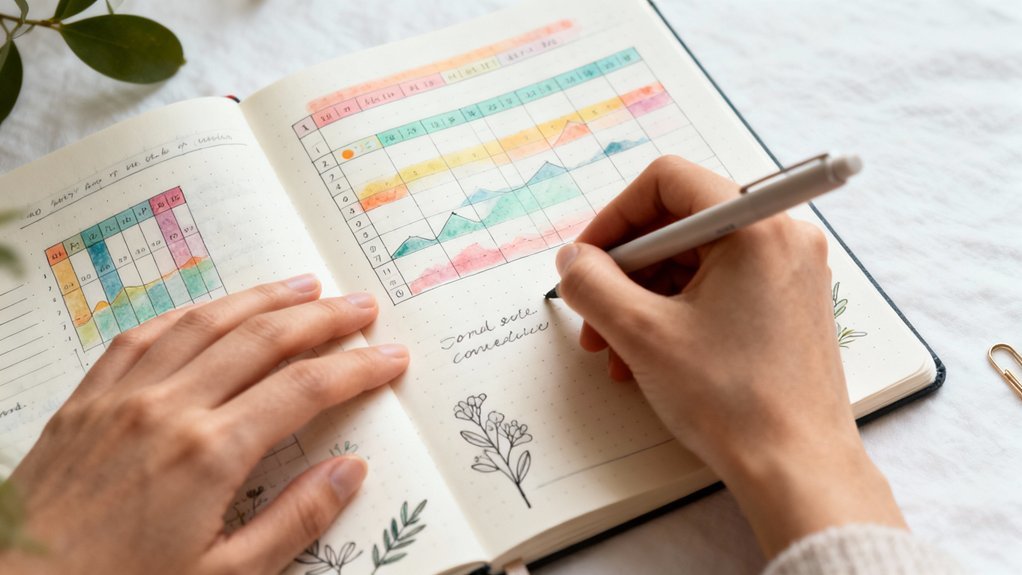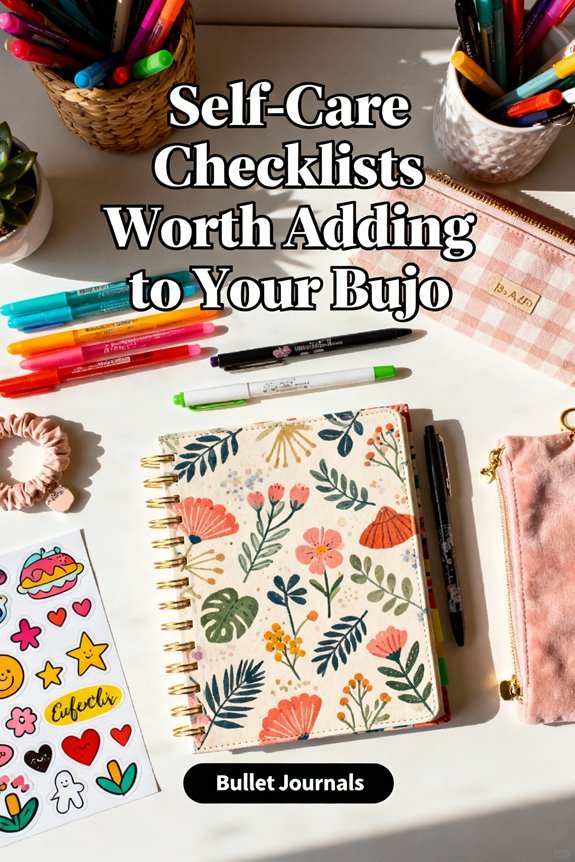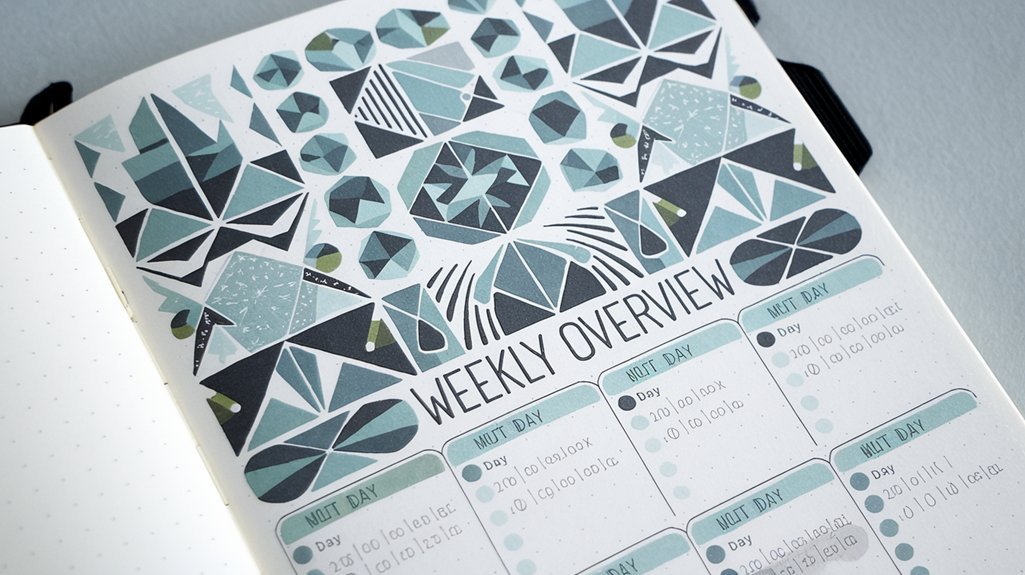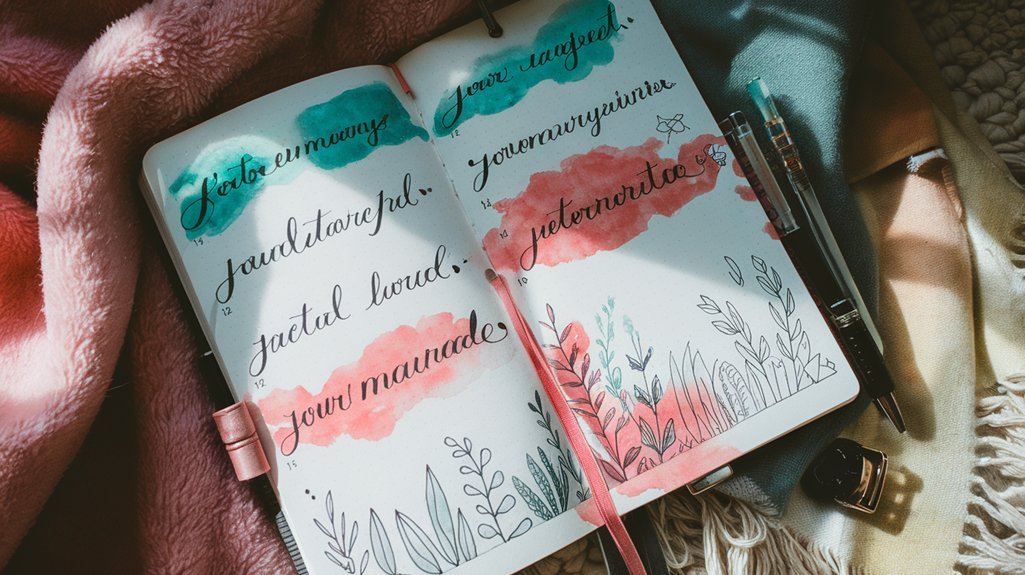Your bullet journal becomes a powerful self-care tool when you track what genuinely maintains your wellbeing. Start with manageable wellness trackers—hydration logs, simple nutrition metrics, and movement frequency rather than ambitious routines. Add mental health check-ins that identify emotional patterns, sleep quality monitoring to enhance your energy, and social connection logs that change relationship maintenance from reactive to proactive. Include boundary check-ins and time audits to protect your resources. These evidence-based spreads turn intentions into observable patterns, helping you understand what truly supports your physical and emotional health.
Key Takeaways
- Track hydration, nutrition metrics, and movement frequency to build sustainable physical wellness habits with 40% better adherence.
- Monitor sleep patterns and energy levels to identify correlations and optimize daily task scheduling around natural rhythms.
- Document mood patterns, triggers, and emotional responses to develop agency over mental health and coping strategies.
- Log social connections with contact frequency and interaction quality to transform relationship maintenance from reactive to proactive.
- Conduct weekly boundary check-ins and energy expense tracking to identify overextension and maintain sustainable commitments.
Daily Physical Wellness Trackers That Actually Work
When you're struggling to maintain healthy habits, vague intentions like “drink more water” or “exercise regularly” rarely translate into action.
Physical wellness trackers convert abstract fitness goals into measurable data points that drive consistency.
Start with a hydration tracker that quantifies your daily intake—research shows visual progress markers increase adherence by 40%.
Pair this with a simple nutrition log focusing on three metrics you're actually willing to monitor, whether that's protein intake or vegetable servings.
For movement, design trackers that reflect your reality. Log exercise frequency rather than ambitious workout routines you'll abandon.
Include flexibility exercises alongside strength training to prevent the burnout that comes from overly rigid programs.
The innovation lies in customization: your active lifestyle tracker should evolve with your needs.
Track what energizes you, not what you think you should do.
This evidence-based approach acknowledges that sustainable wellness emerges from honest self-assessment, not perfectionistic standards.
The Bullet Journal Method excels at this because it adapts to current circumstances rather than imposing rigid structures that fail under real-world pressure.
Mental Health Check-In Spreads for Emotional Balance
Your bullet journal can become a powerful tool for understanding your emotional patterns and building mental resilience.
Research shows that regularly tracking your moods, documenting gratitude, and identifying triggers helps you recognize what affects your wellbeing before small issues escalate.
These mental health spreads create a private space where you'll notice patterns in your emotions, celebrate positive moments through affirmations, and develop awareness of situations that challenge your emotional balance.
By combining time management techniques with emotional tracking, you'll discover how your daily schedule and activities directly impact your mental wellbeing.
Mood Tracker Layout Ideas
Experiment with hybrid layouts combining multiple tracking methods.
You're not confined to traditional formats—design systems that reflect how you actually experience emotions, making self-monitoring both meaningful and sustainable.
Gratitude and Affirmation Pages
Gratitude and affirmation pages create dedicated space for intentional positive reflection, serving as psychological anchors during difficult periods.
You'll design spreads that incorporate gratitude prompts like “What made me smile today?” or “Who supported me this week?” to redirect attention toward meaningful experiences. Research shows consistent gratitude practice rewires neural pathways, enhancing emotional resilience.
Your affirmation statements work differently—they're forward-focused declarations that challenge negative self-talk. Write them in present tense: “I'm capable of growth” rather than “I will be better.”
Rotate weekly affirmations or create theme-based collections addressing specific struggles.
Consider hybrid layouts where gratitude entries inform personalized affirmations, creating a feedback loop between acknowledgment and aspiration.
This integration alters passive journaling into active mental health maintenance, giving you measurable tools for tracking psychological shifts over time.
Trigger Identification and Patterns
When emotional patterns remain invisible, they control you—but tracking them through structured spreads alters reactive experiences into observable data. Your bullet journal becomes a laboratory for trigger awareness, documenting emotional responses alongside contextual factors. This systematic approach supports habit formation around healthier coping strategies while identifying stress triggers before they escalate.
| Trigger Category | Physical Signals | Effective Response |
|---|---|---|
| Social overwhelm | Jaw tension, fatigue | 15-minute solitude |
| Work deadlines | Shallow breathing | Time-blocking |
| Interpersonal conflict | Stomach tightness | Boundary statement |
Design spreads that capture situation-emotion-reaction sequences. You'll recognize patterns within weeks, changing unconscious habits into conscious choices. This evidence-based practice doesn't eliminate difficult emotions—it gives you agency over your responses, creating sustainable pathways toward emotional regulation.
Sleep and Energy Level Monitoring Systems
Tracking your sleep patterns and daily energy fluctuations in your bullet journal creates a tangible record that reveals connections you might otherwise miss.
You'll discover how your 3 PM energy crash correlates with inadequate sleep the night before, or how certain activities drain or restore your reserves.
Design a simple tracking system that captures bedtime, wake time, sleep quality (1-5 scale), and hourly energy levels throughout your day. This data becomes invaluable for optimizing your sleep hygiene—identifying which pre-bed routines actually help versus those that don't.
Energy optimization isn't about maintaining constant productivity; it's about understanding your natural rhythms. You might notice you're sharpest mid-morning or that recovery time after social events varies based on sleep debt.
These insights enable you to schedule demanding tasks strategically and recognize when rest isn't optional—it's necessary. Your bullet journal alters subjective feelings into objective patterns you can actually work with.
Creative Expression and Hobby Commitment Pages

Your creative pursuits deserve the same intentional tracking as other self-care practices, yet they're often the first activities abandoned during stressful periods.
Research shows that engaging in creative hobbies for just 45 minutes reduces cortisol levels and improves overall psychological well-being.
Track Your Creative Projects
Creative pursuits often fall by the wayside when life gets hectic, yet they're essential for mental wellbeing and stress relief. Your bullet journal can become a dedicated space to track creative projects from conception to completion.
Design spreads that capture project inspiration as it strikes—whether that's a watercolor painting, knitting project, or writing endeavor. Research shows that tracking progress on creative work increases both motivation and follow-through rates.
Create sections for active projects, listing materials needed, time invested, and specific creative milestones you've achieved. This visual documentation helps you recognize patterns in when you're most productive and which projects truly energize you.
You'll convert sporadic creative dabbling into intentional practice, making self-care through creativity a consistent priority rather than an occasional indulgence.
Schedule Regular Art Time
Making time for artistic expression requires more than good intentions—it demands concrete scheduling. Your bujo can change aspirations into reality by designating specific time blocks for creative practice. Research shows that consistency strengthens neural pathways associated with artistic skills, making regular sessions more valuable than sporadic marathons.
Create a dedicated spread tracking your weekly art appointments. Block out 15-30 minute increments, treating them as non-negotiable commitments. Document which creative techniques you'll explore—watercolor, sketching, digital design—preventing decision fatigue when inspiration strikes.
Include a section capturing moments of artistic inspiration: overheard conversations, color combinations, interesting textures. This reservoir guarantees you're never starting from scratch.
Track completion rates to identify patterns in your creative energy, optimizing scheduling for peak productivity while maintaining self-compassion during slower periods.
Document Skill Progress Monthly
While tracking daily practice builds momentum, monthly documentation reveals the life-changing arc of your creative journey. Your bullet journal becomes a powerful tool for skill assessment when you dedicate pages to capturing tangible growth markers.
Progress visualization converts abstract improvement into concrete evidence you can revisit during challenging periods.
Create meaningful monthly spreads with these elements:
- Before-and-after sketches showing technique refinement from week one to week four
- Skill ratings matrix tracking specific abilities like color mixing, perspective, or composition
- Milestone markers celebrating breakthroughs, completed projects, or conquered challenges
- Reflection prompts documenting what worked, what didn't, and your evolving creative voice
This systematic approach validates your commitment while illuminating patterns in your learning process, helping you identify which practices accelerate growth most effectively.
Social Connection and Relationship Maintenance Logs

Because meaningful relationships require intentional effort to maintain, tracking your social connections in a bullet journal can help you nurture the bonds that matter most.
Create a simple log documenting when you last connected with important people in your life, noting the communication method and quality of interaction.
Research shows that consistent relationship check ins strengthen social bonds and reduce feelings of isolation. Your tracker might include columns for contact frequency, pending plans, and conversation topics you'd like to explore.
This systematic approach alters friendship maintenance from reactive to proactive.
You'll identify patterns quickly—perhaps you're neglecting certain connections or overextending in others. Set realistic goals like “reach out to three friends monthly” or “schedule quarterly video calls with distant family.”
This data-driven method isn't about obligation; it's about aligning your actions with your values. You're designing a social ecosystem that supports your wellbeing while honoring the relationships you've deemed significant.
Personal Boundaries and Time Management Checklists
Strong relationships thrive when you also protect your personal resources—your time, energy, and attention.
Protecting your time, energy, and attention isn't selfish—it's essential for showing up authentically in your relationships.
Personal boundaries and time management checklists convert abstract intentions into concrete actions, helping you honor commitments to yourself while maintaining healthy connections with others.
Effective boundary setting and time allocation require regular tracking. Your bujo can include:
- Weekly boundary check-ins: Document moments you said “yes” when you meant “no,” then identify patterns and triggers.
- Time block audits: Review how your scheduled priorities matched actual time spent, highlighting discrepancies between values and actions.
- Energy expense tracker: Rate activities by how they drain or replenish you, informing future boundary decisions.
- Communication scripts: Draft and refine phrases for declining requests respectfully, making difficult conversations feel more manageable.
These checklists aren't about isolation—they're about sustainable engagement.
When you're clear about your limits, you can show up more authentically for both yourself and others.
Frequently Asked Questions
What Supplies Do I Need to Start a Bullet Journal?
You'll need just a few essential supplies to start your bullet journal: a notebook (dotted or blank pages work best), and a pen you're comfortable writing with. That's it!
Many beginners worry they need expensive materials, but research shows simplicity improves consistency.
As you develop your practice, you can add colored pens, markers, or washi tape if they spark joy.
What matters most isn't perfection—it's creating a system that genuinely supports your self-care journey.
How Do I Stay Consistent With Filling Out My Self-Care Checklists?
Like a garden needing daily watering to flourish, your self-care practice thrives on gentle consistency.
You'll succeed by linking checklists to existing habits—place routine reminders where you already look, like your morning coffee spot.
Research shows motivation strategies work best when you're compassionate with yourself during slip-ups.
Start small: commit to one checkbox daily rather than perfection.
You're building sustainable wellness, not chasing an impossible standard.
Progress, not perfection, creates lasting change.
Can I Use Digital Apps Instead of a Paper Bullet Journal?
Digital journaling can work beautifully for self-care tracking. You'll find app features like reminders, cloud syncing, and data visualization that improve consistency.
Research shows digital tracking increases adherence for many people. However, some find handwriting more mindful and memorable. You're not choosing wrongly either way—what matters is finding your sustainable method.
Try experimenting with apps like Notion, Daylio, or Habitica alongside or instead of paper. Your self-care practice should adapt to your lifestyle, not constrain it.
How Often Should I Review and Update My Self-Care Trackers?
Review your self-care trackers weekly for progress assessment, but don't stress if you miss a session—rigidity defeats the purpose.
While daily check-ins work for some, others thrive with monthly self reflection frequency. Research shows consistency matters more than perfection.
You'll discover what rhythm supports your growth through experimentation. If tracking becomes draining rather than uplifting, that's valuable data too.
Adjust your review schedule based on what genuinely serves your wellbeing, not arbitrary rules.
What if I Miss Several Days of Tracking?
Don't worry—missing days is completely normal and doesn't negate your progress.
Practice guilt-free planning by simply starting fresh where you're today. Research shows that self-compassion actually improves habit adherence more than self-criticism does.
Focus on reintegrating habits gradually rather than perfectly catching up. You might modify your tracker to accommodate gaps or restart with a new spread.
What matters isn't consistency; it's your willingness to continue. Every moment offers a fresh opportunity to reconnect with your self-care intentions.
Conclusion
You've probably heard that self-care is selfish—but research proves the opposite. When you're tracking your wellness, you're actually becoming more present for others. These checklists aren't about perfection; they're about noticing patterns and honoring your needs without guilt. Your bullet journal becomes evidence of your commitment to yourself, and that's not indulgent—it's essential. Start with just one spread that resonates, and you'll discover what genuine self-compassion looks like in practice.








